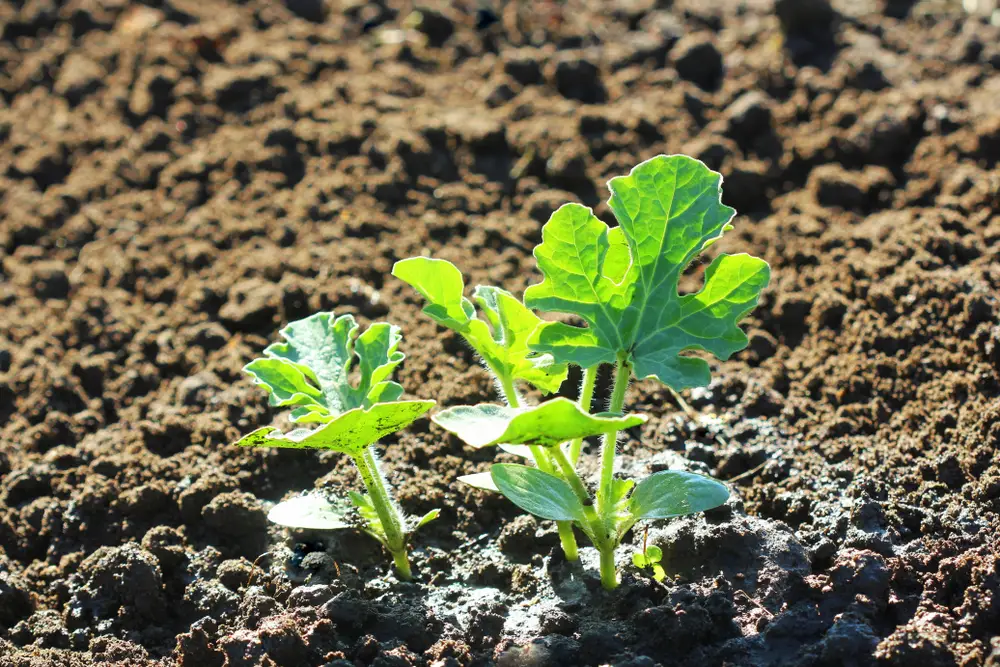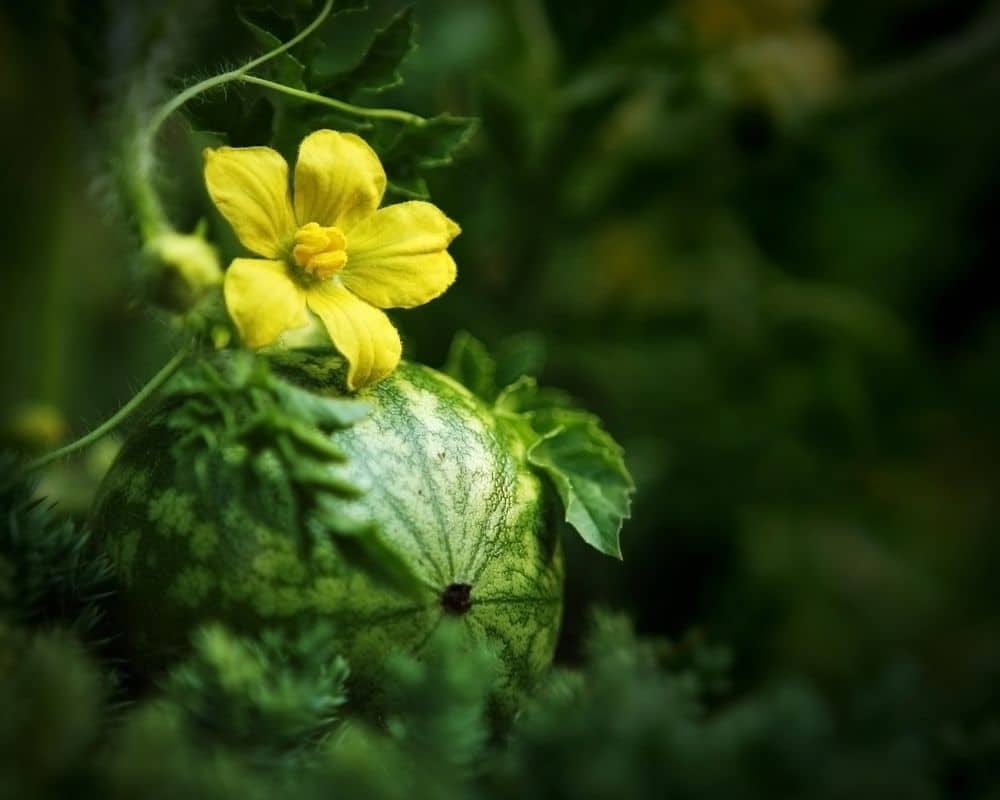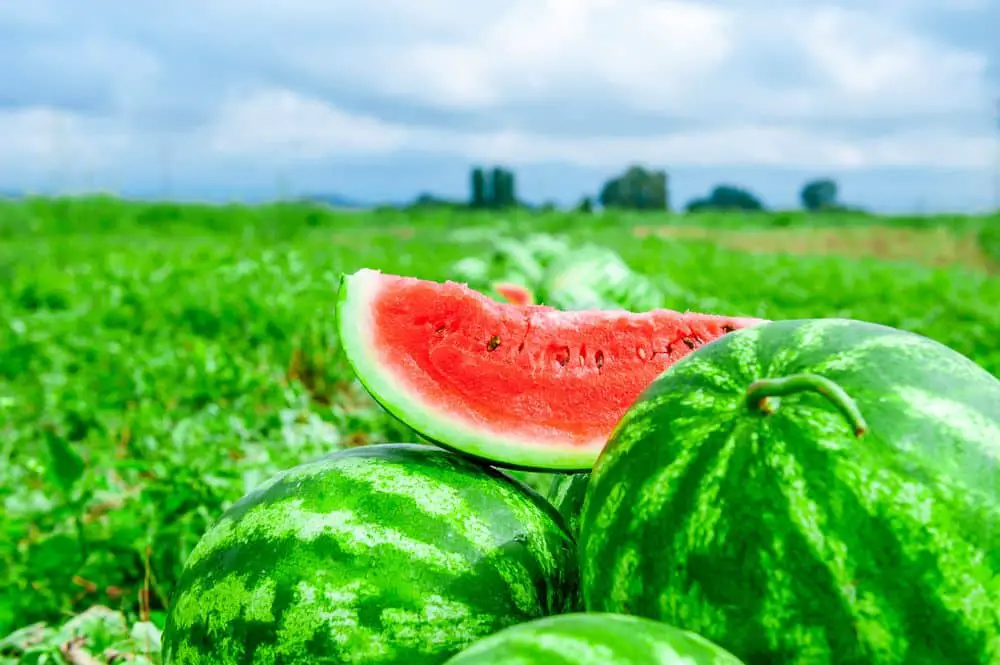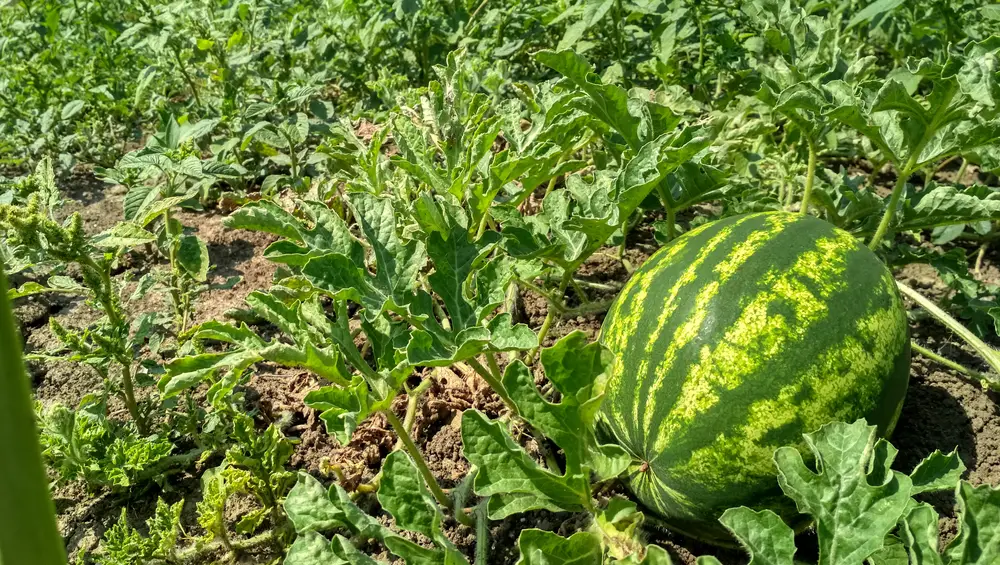Watermelons are one of the most popular fruits to plant and consume. As a gardener, knowing about the Watermelon’s growing stages can help you to grow an abundance of this delicious fruit.
The 5 Watermelon Growing Stages are:
- Planting and Germination
- Vining
- Flowering
- Fruit Bearing
- Harvesting.
If you are interested in growing Watermelons, here is what you need to know about the Watermelon growing stages.
This ensures that you grow and harvest them properly at the right time.
Stage 1: Planting and Germination
A Watermelon seed is black, small, hard, and with a smooth texture. In some instances, the seeds are white and soft, but these types of seeds have a small percentage of growth.
Watermelon fruit can have 40 to over 60 seeds in one fruit. A ripe Watermelon fruit (green) will give you high-quality seeds.
Plant the Watermelon seeds when temperatures are above 650F. Bury the seeds in the soil with a depth four times the seed’s width.
If you start planting your Watermelon seeds indoors, transplant the seedlings when it has grown more leaves and are 6 to 10 inches long. You can also opt to plant the seeds directly on the soil.
Water the seeds so they will germinate. The seeds will germinate after 4 to 14 days. They will grow some roots and some small leaves after a few days.
Care for your seedlings more at this stage because their stems are still soft; otherwise, the stem will cut, dry, and stop growing.

Stage 2: Vining
The first set of true leaves will come out 5 to 10 days after germination. At this stage, the leaves of your Watermelon plant are already capable of photosynthesis (the ability of plants to convert sunlight to carbon dioxide and to convert water to food.
A vine, about 1 foot long, will grow from your plant. Large d leaves will also begin to form.
The vine will continue to grow up to 12 feet long. Several more vines will grow one month after the first vine sends out.
You will need to give your Watermelon plant more care at this stage than at any of the earlier stages. The vines will start to climb. Watermelons are vine fruits, growing on the soil and not needing a trellis.
Water your Watermelon seedlings with at least 1 to 2 inches of water per week. With sufficient sunlight, water, and fertilizer, good Watermelon will appear from your plant.
Stage 3: Flowering
Your Watermelon plant will grow flowers after smaller runner vines grow from the main vine. This is about two weeks after your plant grows most of its vines. At this time, your Watermelon plant will be about 60 to 70 days old.
Male flowers with stalks covered in pollen (stamens) at the centers will appear first but they will not produce fruits.
Female flowers with a sticky stigma will appear shortly afterwards.

The flower of your Watermelon is sensitive so you need to care for it as it may fall when something hits it, especially animals that roam your garden.
At this stage, your need to water and fertilize your plant more. Water your plant every day or as it needs it. Fertilize it, too.
Many gardeners who grow Watermelon plant shrubs or flowers nearby or install beehives to encourage pollinators such as hummingbirds, bees, or butterflies. You can also pollinate by hand if there are no pollinators in your garden.
To pollinate by hand, pick a male flower. Brush the male flower over the female flowers of other plants. You can also use a small paintbrush or cotton swab to brush the pollen onto the stigma (center of the female flowers) to pollinate them.
The concept of pollination is to transfer the pollen from the stamens (from male flowers) to the stigmas (of female flowers).
Stage 4: Fruit Bearing
Female Watermelon flowers will start to produce fruits after successful pollination. This is the stage when the flowers of your plant will start to form young Watermelon fruits.
When your Watermelon plant starts to bear fruits, it should be 70 to 80 days old. You must take more care of your plant at this stage as pests can attack the Watermelon fruits.
When fruits start to set, you will need to top-dress your plants with fertilizer (5-10-10). When the plant grows fruits, give them one inch of water per week until harvest.
Fruits, appearing as green balls, will swell underneath the flowers. After about a month, the Watermelon fruit will become fully developed, mature, and ripe.
Stage 5: Harvesting
The Watermelon growing stages end when the fruit is ready for harvesting. This is when the Watermelon is mature enough to be consumed.
end when the fruit is ready for harvesting. This is when the Watermelon is mature enough to be consumed.
Knock your hand against the Watermelon fruit. If you hear a hollow sound, your Watermelon is ripe.

It is also ripe when the area around the fruit resting against the ground turns white to yellow. When the tendrils along the vines turn from green to brown, the fruit is ripe.
You can use the seeds of the Watermelon fruit to grow new Watermelon plants. Allow the seeds to dry before planting them.
plants. Allow the seeds to dry before planting them.
How Long does the Watermelon Growing Stages Take?
The Watermelon growing stages take about three months. The first two are the planting, germination, vining, and flowering stages. In the third month, the Watermelon fruit will start to develop.
The time it takes from planting the seeds to the time the Watermelon fruit reaches full maturity also depends on the variety of Watermelon. Smaller Watermelon varieties develop faster and can be harvested before larger Ones.
Watermelon fruits grow for only one season, making them a quick crop.
About Watermelons
Watermelons are berries – therefore they are fruits and not vegetables . However, they are generally referred to as veggies. They are annual plants with vines and roots that can spread up to 18 feet. They prefer to grow in well-drained and sandy soils. It is best to plant seeds 6 feet apart.
. However, they are generally referred to as veggies. They are annual plants with vines and roots that can spread up to 18 feet. They prefer to grow in well-drained and sandy soils. It is best to plant seeds 6 feet apart.
Watermelons grow well in warm weather. They can also be grown in colder climates by planting seeds indoors or buying young plants.
In warmer climates, Watermelons have long growing seasons. Plant the seeds outdoors about one or two weeks after the last frost date, when the soil temperature is at least 650F.
In cool climates, Watermelons have short growing seasons. Start by planting the seeds indoors also two to three weeks before the last frost date. Transplant the seedlings in the ground when the soil temperature is at least 650F.
Where can you Plant Watermelons?
Prepare the site where you intend to plant your Watermelon seeds.
- Watermelons prefer slightly acidic to neutral soil with a pH of between 6.0 and 7.5
- These plants thrive in well-drained, loamy, and slightly sandy soil. They will struggle in clay soil because it is not well-draining.
- It is also better to amend your soil with seaweed, and composed, or aged manure, before planting the seeds.
- Watermelons need fertile soil with high levels of nutrients because they are heavy feeders.
- It is best to grow Watermelon in raised rows or hills so their vines will have good drainage and hold the sun’s heat longer.
- Plant Watermelon seeds 2 – 3 feet apart in a hill that is 5 feet wide. Plant them 6 feet apart if you are planting Watermelon seeds in typical rows.
- The vines of your Watermelon plant need space to sprawl. Plant them in a spot where they will not crowd other crops.
Plant your Watermelon seeds in the best conditions to ensure a high-quality yield.
Origins and Other Names of Watermelons
Watermelons (Citrullus vulgaris) are flowering plant vines from the Cucurbitaceae family. This family includes zucchinis, pumpkins, winter melons, cantaloupes, and cucumbers.
Watermelons originated from West Africa, with many people cultivating this plant since 2000 BC in over 1000 varieties. They can be found in many parts of the world.
Final Thoughts on 5 Watermelon Growing Stages (Easy Growth)
It is rewarding and fulfilling to grow Watermelons. Most gardeners who grow them more often get a high yield.
Knowing about the plants’ growing stages can help you troubleshoot any challenges that may confront you.
can help you troubleshoot any challenges that may confront you.
This knowledge can make growing Watermelons stress-free and fun.
Our editor, Patricia Godwin, who has done many courses and ongoing training regarding gardening and plants, brings a wealth of experience to this topic. She owned and ran a successful landscaping and gardening service for many years, where she had the opportunity to test various techniques and products for growing vegetables, including watermelons.
Read More:
How to Grow Cantaloupe: 6 Easy Tips for Growing Cantaloupe!
Pumpkin Vine Care – 5 Expert Tips!
The following sources were consulted during the research for this article:
Academia
Science.gov

